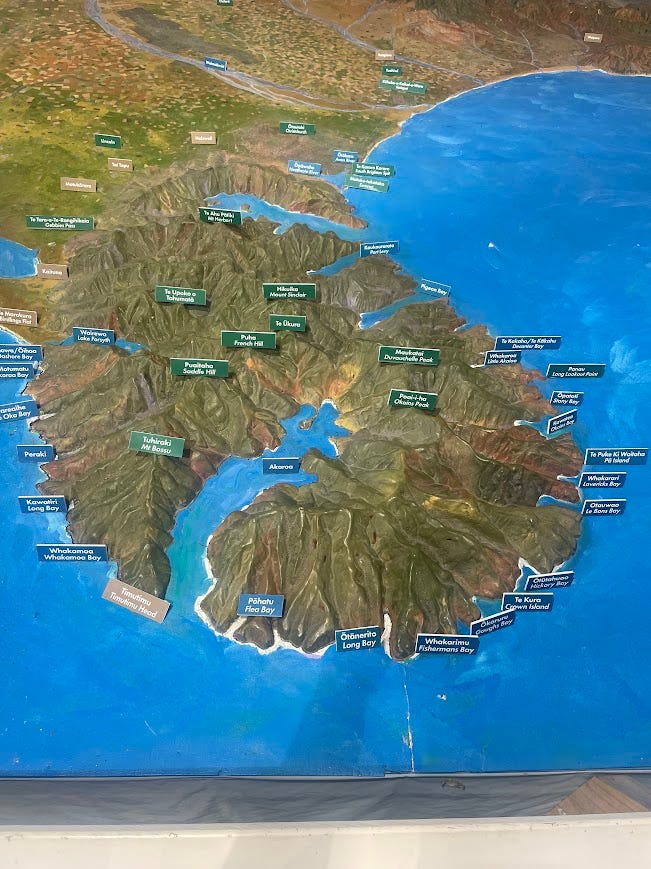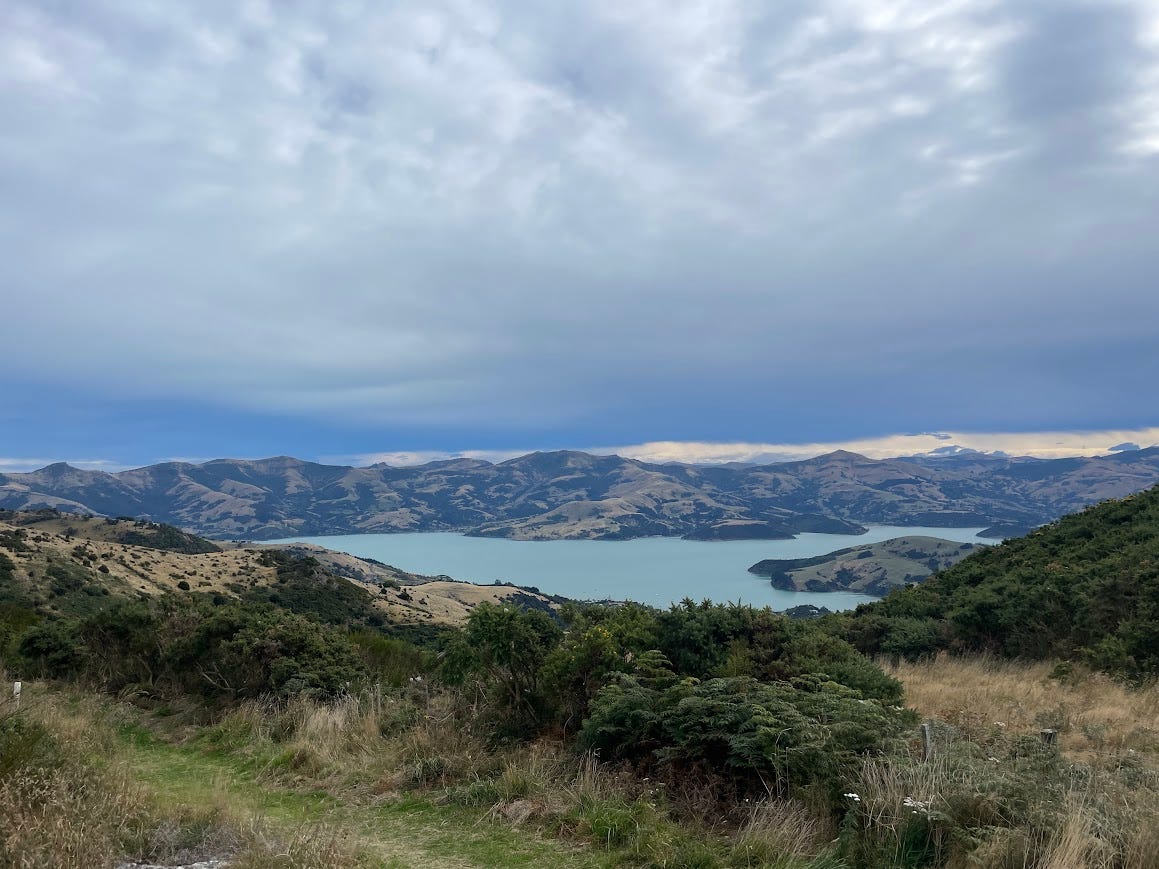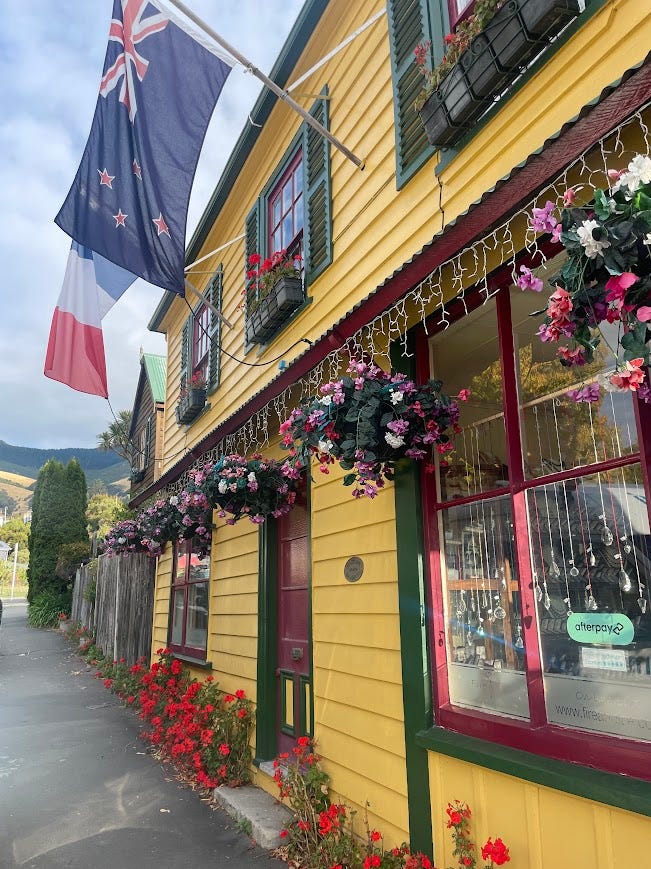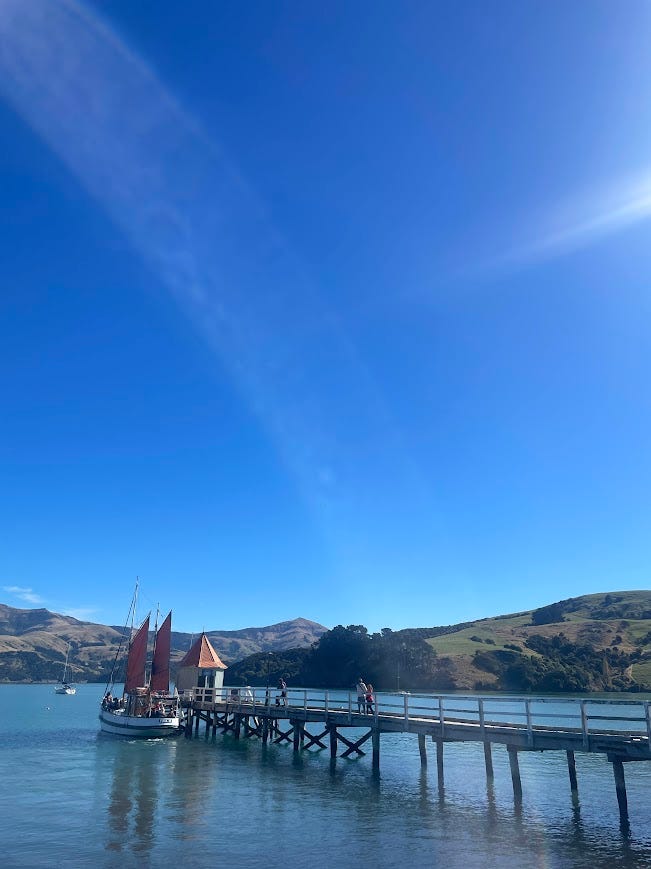Bonjour!
Hope this update finds y’all healthy and happy! We are writing from Akaroa, where we are finally putting the work into our working holiday! We have jobs waiting tables at a local restaurant, which has helped us achieve our goals of meeting new people, settling in one place a little bit longer, and making the trip financially sustainable.
We’d love to tell you about the idyllic town where we’ve landed: Akaroa! Our first impressions hold up as the charming Banks Peninsula continues to unfold before us. The region was formed by two volcanic eruptions over six million years ago into this unique and intricate series of bays. On a map, it kind of looks like a tie-dye spiral, or maybe a crab claw?
The town sits on the largest and inner bay, which is a former caldera, or volcanic crater! This geography creates stunning views overlooking rolling hills, sheep farms, and patches of dark green trees over golden grasses. If you climb up or go on a scenic drive, you get either the gorgeous view of the inner bay or sublime lookouts out over the Pacific.
The name “Akaroa” (historically spelled Whangaroa) is a Māori word meaning “long harbor.” The first Polynesian settlers to arrive were hunters of the now-extinct flightless bird, the moa (which looked like a cross between a brontosaurus and a kiwi bird). The town also developed into a trading and flax weaving village. In the late 1830s, the French “bought” the land from the Māori, renaming it Port Louis-Phillipe. They intended it to be the base of their colonial expansion to the rest of the South Island. But the British managed to box them out of the colony business in New Zealand with the Treaty of Waitangi. While land ownership disputes continued, French settlement (along with some Germans and Dutch) continued into the 1840s, with the British at the southern end and French at the northern end of the town. At this point, as our French coworkers would confirm, the town is more cosplaying as a French hamlet than anything else. Nevertheless, the architecture is lovely, and a welcome distraction from climbing the steep hills up from the harbor.
The town itself is small enough that it feels quaint, but large enough that you can't see everything in a day, which feels like the level we were aiming for! Add in the fact that it has hills overlooking water, and we’ve found an ideal place to stay for a few months! While there are only about 650 year-round residents, that number balloons during the summer and other holidays. There are two main commercial sections, each surrounding one of the wharfs, with about a five minute walk between them on the waterfront. A few two-to-three story buildings line the main streets (or, rather, rues), but it is mostly cozy French-inspired garden cottages that make up the town. It's the type of small town that has one general store, a small supermarket, and about seven different places where you can buy upscale maritime souvenirs (like a smaller Newport, RI near Chris’s hometown!)
Building Community in the Short-Term
After traveling for a few months, we were excited to hit the ground running on establishing ourselves in one place for a little longer. One of the core themes that we kept coming back to at the start of the trip was the push-pull between “drifting” and “nesting.” It’s the first time in both of our lives that we have been in a period of continuous, long-term travel, and we are loving it! At the same time, we’re taking notes on the interior decorating of all our hosts, and craving a third space to join. Decorating our van had begun to fulfill some of that “nesting” urge, and now settling into the town of Akaroa has even more so! Staying in the spirit of a harbor town, we’re thinking of this as our “anchoring” season. We aren’t putting down roots, but we are sticking around for a while!
We spent our first few days in town walking around, taking pictures of flyers for local events, and chatting with business owners. And we’ve had many serendipitous small town connections! Our very first day in town, while taking a picture of a volunteer firefighting poster, we were quickly invited inside the bar to go meet the assistant fire chief. We also met two volunteers at the local historical library who have stopped by the restaurant where we work several times, and even invited us over for barbecue!

We also attended a local sketching group and met several people involved in the community arts council, whose banter (and gossip!) reminded us of the characters in The Thursday Murder Club series. Last but certainly not least, we have made friends with a neighborhood cat that bounds from seemingly out of nowhere to walk us to and from work.
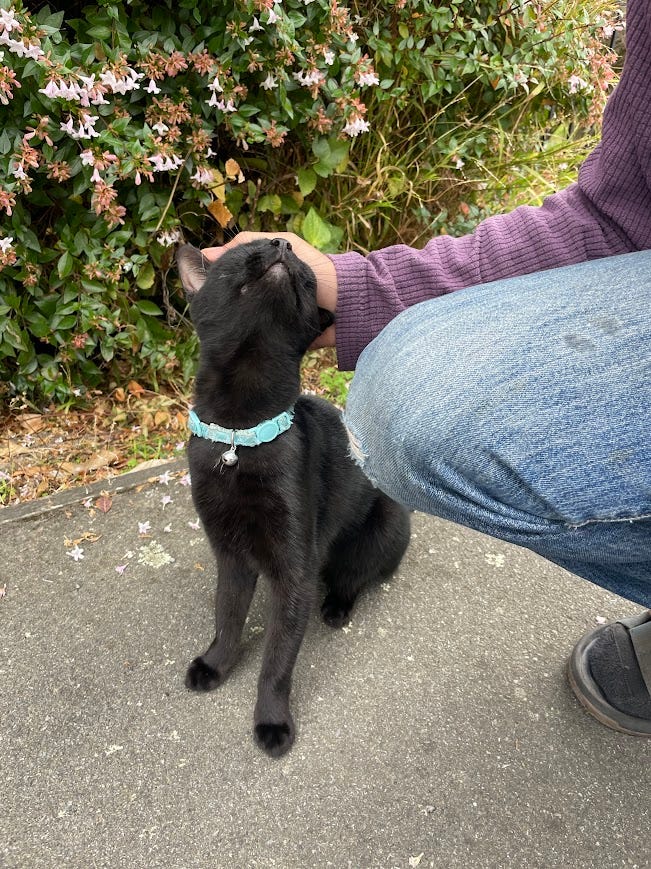
Somewhat paradoxically, the temporary nature of the working holiday has made seeking out community in Akaroa feel easy. We were satisfied to discover this, as we want to have lives centered around community, but didn’t quite know what that might look like while traveling. We know we want to be meaningfully connected to the place(s) we live, and sometimes we want that more quickly than is actually possible. In our experience, community is something you can *feel* when you have it, but when you don’t, it can start to seem more like an abstract concept without obvious steps towards attaining it. You can’t always predict what is going to stick, and this can make the stakes feel high for showing up alone at an event or meeting new people. Sometimes it feels like luck more than effort determines those moments when you encounter lasting friendships or beloved organizations that become the pillars of your life in a place.
In the places we’ve lived long-term, we’ve at times let uncertainty and social anxiety talk us out of putting ourselves out there. It’s easy to fall into the holding pattern of “maybe we’ll check it out next week.” When your goal is to build a life somewhere, the slow and non-linear nature of building community can be really discouraging. Lowering the stakes and adding a time limit has made us take a lot of the same actions we would elsewhere, but with less hesitation and more haste.
Connection to local organizations: The relatively informal nature of applying for working holiday jobs has given us practice at just showing up somewhere that interests us and asking if we can get involved. With the “recess” frame for this year, we have also given ourselves license (and time) to do all the random things we daydreamed about trying — or ones we never thought of, because why not? When we were back in Denver, Rachel would daydream about reaching out to some of our great local vegetarian food trucks about doing some kind of apprenticeship with them. And it felt intimidating to even send them an email, much less walk up and say hi at the farmers’ market. Here, we have conjured up the confidence to cold call, and now may start part-time jobs with a conservation org and/or volunteer gigs with a sailing club (stay tuned)!
Connection to local businesses and routines: We’ve observed that the transition to “living” somewhere as opposed to just visiting happens when you are there long enough to develop a routine, typically one that involves more than leisure/consumption. In our “pre-sabbatical sabbatical” post, we wrote about wanting to find some of these grounding habits even while living somewhere short-term. And we’re really happy this has felt possible in only a few weeks in Akaroa! Perhaps our favorite ritual is getting fresh bread from our local (actually French) baker Thursday through Sunday mornings! Another is sharing a cold Bundaberg, an Australian soft drink, during our mid-afternoon breaks from work. And maybe it’s just the small town making the same faces reappear in different locations, but now it’s hard to imagine not being on a first-name basis with our nearest local businesses.
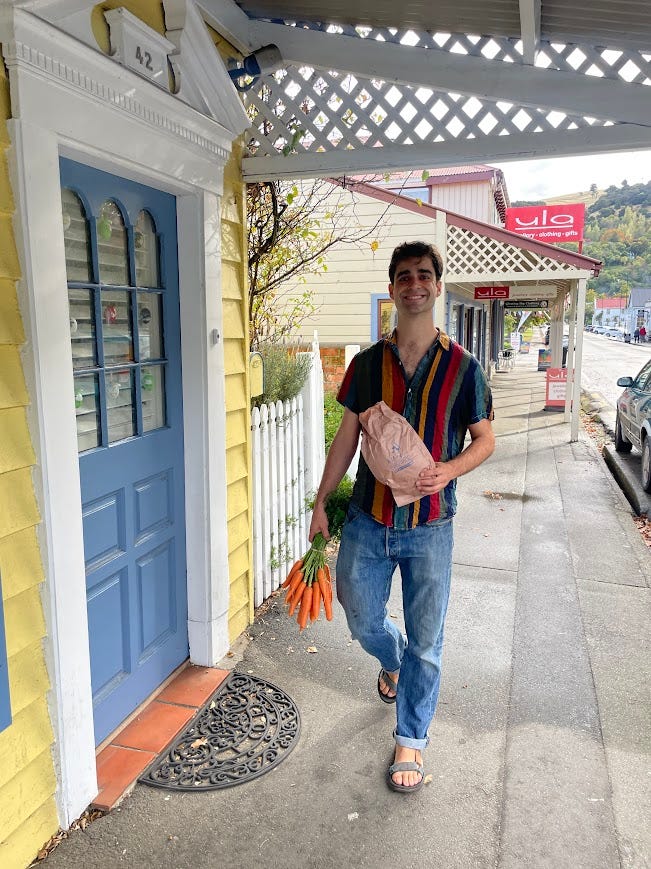
Connection to other people: Finally, being a seasonal worker is probably the closest thing we’ll experience to being students again (well, besides actually becoming students again, which we haven’t ruled out!). We live and work and hang out with the same people! When moving to a new place, it can often feel overwhelming trying to make new friends. If you manage to make friends, you can spend more time scheduling and re-scheduling plans than actually having them. While we have been lucky to find wonderful people everywhere we’ve lived, it’s kind of freeing to be building relationships through sheer proximity and amount of time spent together. It’s wild what details you learn about people’s backstories while restocking drinks from the chiller together. Or exciting to discover your co-workers/housemates want to learn how to play D&D!
The idea for this year was born partially out of sitting behind our laptops, daydreaming about working at a B&B or on a sailboat. We can see now that what we were actually imagining was not necessarily those specific professions, but the feeling of being mentally uncluttered, present, and at ease. We feel really lucky to be living out what we had hoped for in this time, both in the abstract and the specific form it has taken. When we confront obstacles, Chris often returns us to the phrase, “we are building the lives we want.” So much of what we have done this year is gaining confidence to do just that. While we can’t claim to be longstanding pillars of this community, we do feel satisfied with the connections we’ve been able to make in a short time. Though this year is in many ways out of the ordinary, we can already see how much of it we will carry into the future.
What else?
We are still living in our van, but now in the driveway of a lodge that serves as staff housing for the restaurant, so we have access to a kitchen, showers, etc. It’s been a bit of an adjustment living in what feels like student housing, mostly due to the presence of mice and the quantity of empty beer cans. But it’s cheap, and living in the van means we still have our own space. One of our new housemates also took it upon himself to reorganize the living room, fix the unpleasant lighting, and start building fires in the old wood burning stove. It’s pretty amazing how relatively small changes have already made it a space where people are more likely to congregate for a card game or a dramatic reading of love letters left behind in someone’s dresser. The best part of the lodge is the large wraparound porch, from which you can see the hills in the distance and hear beautiful birdsong, including from the New Zealand wood pigeon (kererū)! On Chris’s ever-growing list of favorite birds, it’s more striking than your average city slicker pigeon, and makes a really distinct noise when it flaps its wings that sounds like a sci-fi hovercraft.
And writing from that porch is where we leave you now! There’s lots more to say on our hospo jobs, whether it be how chill it is not working for tips or how shocked we are that lemonade and Sprite are considered the same thing here. For now, we’ll leave you with a photo of the world’s smallest dolphins, some of the longest-standing residents of this harbor we’ve met!



